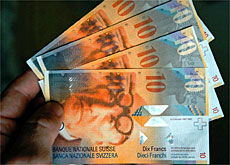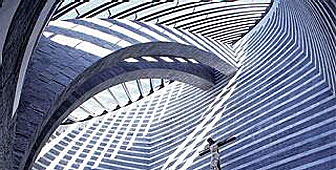Reconstructing Le Corbusier’s Swiss legacy

Until recently, the importance of Le Corbusier's formative years in Switzerland has been downplayed, if not neglected.
But swissinfo’s Dale Bechtel discovered during a tour of the great architect’s birthplace, La Chaux-de-Fonds, that his Swiss legacy is worth a lot more than the SFr10 banknote which his face adorns.
The fact that the “Maison Blanche”, the house Le Corbusier built for his parents in 1912, is in a state of disrepair, says much about the relationship between the watchmaking town and its native son.
The architect, designer and city planner settled in Paris in 1917 and a couple years later discarded his real name, Charles-Edouard Jeanneret, to become Le Corbusier.
He died a naturalised French citizen in August 1965 in the South of France, having turned his back on his Swiss past.
But the influence of Le Corbusier’s early years in La Chaux-de-Fonds is currently undergoing something of a reappraisal.
Exhibition
An exhibition in New York, entitled “Le Corbusier Before Le Corbusier: Applied Arts, Architecture, Painting, and Photography, 1907- 1922”, highlights the importance of the applied arts in the early development of Le Corbusier’s approach to architecture and design.
And now a foundation has purchased the Maison Blanche with a view to restoring the building and turning it into a museum.
The Maison Blanche is just one of the houses included on a walking tour of La Chaux-de-Fonds, which also takes in examples of Le Corbusier’s furniture at the museum of fine arts and documents in the archives of the local library.
The Maison Blanche and other houses from this period line the road, “chemin de Pouillerel”, on a hill overlooking the town.
First commission
Of these, the Villa Fallet was the first commission awarded to Jeanneret and fellow students of the advanced course at La Chaux-de-Fonds art school.
The school’s main task was to churn out engravers for the town’s watchmaking industry, and the façade of the Villa Fallet is as rich in ornamentation as the pocket watchcases Jeanneret was trained to make.
The school had a reputation for turning out highly skilled craftsmen, according to Arthur Rüegg, a professor of architecture at the Federal Institute of Technology in Zurich and a leading Le Corbusier scholar. Rüegg is one of the organisers of the new exhibition.
He says Le Corbusier’s trademark precision drawings bear witness to his early training as an engraver.
“He could draw very precisely and quickly so it was his training as an engraver which influenced him very much.”
Like the Villa Fallet, there are two other villas on chemin de Pouillerel from the period before Jeanneret served his much-documented apprenticeships in France and Germany and went on his self-imposed grand tour of southern Europe and the Balkans.
Master architect
But you only have to turn the corner to see how in a few short years the young art student was maturing into Le Corbusier, the architect.
Entranced by the traditional architecture of Rome and Istanbul, and having soaked up the modernist methods of Peter Behrens and Auguste Perret, Jeanneret’s new ideas and concepts first found expression in the Maison Blanche.
He began to put accents on landscape architecture influenced by what he had seen in Istanbul and, according to Leo Schubert in the book accompanying the new exhibition, “the interplay, observed in Rome, between the prefixed wall and the main structure behind”.
This was in 1912. He had returned home to live and had decided to pursue architecture as a profession.
An original copy of the letter announcing his ambitions is kept in the archives of the local library alongside sketches, boxes of travel photographs and correspondence with his parents.
Reinforced concrete
He states in the letter that he is an architect of villas, country houses, industrial and interior design, specialising – as he emphasises – in the use of reinforced concrete.
However, it would be another four years before his next architectural commission.
He spent the intervening period designing interiors and furniture for La Chaux-de-Fonds’ elite – mostly wealthy watchmaking industrialists from the town’s Jewish community.
Some of the furniture including armchairs, bookcases, sideboards and cabinets is on permanent display at the town’s museum of fine arts.
“He used architectural themes to formulate furniture and within the furniture tried to find new architectural combinations that he could then apply to architecture,” says Rüegg.
With a little imagination, says Rüegg, details of a cabinet made for Robert Ditisheim in 1915 are similar to the façade of the Villa Schwob.
Designed for one of the town’s influential watchmakers, the Villa Schwob is the last house Jeanneret built in La Chaux-de-Fonds.
Turkish villa
Also known as the Villa Turque, it was yet another major step in the young architect’s maturing process.
It is a hybrid of modern and classical design, and is strong on geometric volumes with a two-story central hall and full studio window.
It reveals Jeanneret experimenting with the structural freedom afforded by the novel use of reinforced concrete as a material for house construction.
Amid cost overruns and legal disputes, Jeanneret – now aged 30 – chose to leave La Chaux-de-Fonds before the Villa Schwob was completed to settle in Paris.
But it was eventually finished, and he saw it for the first time two years later in 1919.
It inspired the young architect so much that he commented: “I want to paint serious… paintings that are at least an extension of my Villa Schwob. I am fixated on the Parthenon and Michelangelo.”
Villa Schwob
The Villa Schwob is now owned by the luxury watchmaking company, Ebel, which uses it as the public relations centre.
Ebel coincidentally markets its watches using the slogan, “The Architects of Time”.
The company’s Jean-Claude Roustant explains that the building is an ideal showcase for the luxury timepieces.
“I don’t know if our designers have been influenced by the villa, but it’s fantastic to have such a perfect bonding between a product and a house.”
Like clockwork, Ebel opens the Villa Schwob’s doors to the public on the first and third Saturdays of each month.
swissinfo/Dale Bechtel
Born in 1887, Charles-Edouard Jeanneret was a trained watch engraver before becoming an architect.
He left his hometown, La Chaux-de-Fonds, in 1917 to settle in Paris where he changed his name to Le Corbusier.
Early houses, art work and furniture can be seen during a visit to La Chaux-de-Fonds.
An exhibition at the Bard Graduate Center in New York focuses on the work from his formative years.

In compliance with the JTI standards
More: SWI swissinfo.ch certified by the Journalism Trust Initiative











You can find an overview of ongoing debates with our journalists here . Please join us!
If you want to start a conversation about a topic raised in this article or want to report factual errors, email us at english@swissinfo.ch.